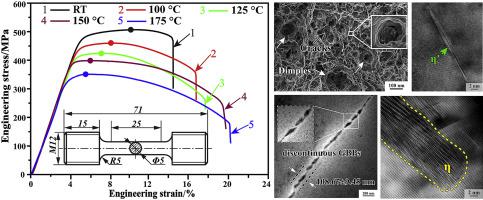当前位置:
X-MOL 学术
›
Prog. Nat. Sci. Mater. Int.
›
论文详情
Our official English website, www.x-mol.net, welcomes your
feedback! (Note: you will need to create a separate account there.)
High temperature tensile properties, fracture behaviors and nanoscale precipitate variation of an Al–Zn–Mg–Cu alloy
Progress in Natural Science: Materials International ( IF 4.8 ) Pub Date : 2020-02-01 , DOI: 10.1016/j.pnsc.2020.01.007 Pan Dai , Xian Luo , Yanqing Yang , Zongde Kou , Bin Huang , Jinxin Zang , Jigang Ru
Progress in Natural Science: Materials International ( IF 4.8 ) Pub Date : 2020-02-01 , DOI: 10.1016/j.pnsc.2020.01.007 Pan Dai , Xian Luo , Yanqing Yang , Zongde Kou , Bin Huang , Jinxin Zang , Jigang Ru

|
Abstract In order to assess Al–Zn–Mg–Cu alloys as potential high temperature structural materials, the hardness, tensile properties and fracture behaviors of 7085 Al alloy were investigated at various temperatures from room temperature to 175 °C. High-resolution transmission electron microscopy was used to investigate the evolutions of precipitates at different temperatures, particularly on the relationship between microstructural evolution and tensile strength. The results reveal that both the microstructure and mechanical properties of the alloy are quite sensitive to the environmental temperature. As the temperature increases, the hardness and strength decrease while the elongation and reduction of area increase. As tensile testing temperature rises, the strain hardening exponent (n) decreases due to the thermal softening effect. The fracture mode of the alloy transforms from mixture of intergranular and transgranular fracture to completely transgranular dimples when tensile testing temperature reaches 150 °C. The precipitate sequence during high temperature tests is coincident with that of aging. With the increase of tensile testing temperature, the mean precipitate radius grows larger, and the distribution of grain boundary precipitates transforms from continuous to discontinuous.
中文翻译:

Al-Zn-Mg-Cu合金的高温拉伸性能、断裂行为和纳米级析出物变化
摘要 为了评估 Al-Zn-Mg-Cu 合金作为潜在的高温结构材料,研究了 7085 铝合金在室温至 175 °C 不同温度下的硬度、拉伸性能和断裂行为。高分辨率透射电子显微镜用于研究不同温度下沉淀物的演变,特别是微观结构演变与抗拉强度之间的关系。结果表明,合金的显微组织和力学性能对环境温度非常敏感。随着温度的升高,硬度和强度降低,而伸长率和面积减少量增加。随着拉伸试验温度升高,应变硬化指数 (n) 由于热软化效应而降低。当拉伸试验温度达到150 ℃时,合金的断裂方式由晶间和穿晶断裂的混合断裂转变为完全穿晶的凹坑。高温试验析出物顺序与时效一致。随着拉伸试验温度的升高,析出物平均半径变大,晶界析出物的分布由连续向不连续转变。
更新日期:2020-02-01
中文翻译:

Al-Zn-Mg-Cu合金的高温拉伸性能、断裂行为和纳米级析出物变化
摘要 为了评估 Al-Zn-Mg-Cu 合金作为潜在的高温结构材料,研究了 7085 铝合金在室温至 175 °C 不同温度下的硬度、拉伸性能和断裂行为。高分辨率透射电子显微镜用于研究不同温度下沉淀物的演变,特别是微观结构演变与抗拉强度之间的关系。结果表明,合金的显微组织和力学性能对环境温度非常敏感。随着温度的升高,硬度和强度降低,而伸长率和面积减少量增加。随着拉伸试验温度升高,应变硬化指数 (n) 由于热软化效应而降低。当拉伸试验温度达到150 ℃时,合金的断裂方式由晶间和穿晶断裂的混合断裂转变为完全穿晶的凹坑。高温试验析出物顺序与时效一致。随着拉伸试验温度的升高,析出物平均半径变大,晶界析出物的分布由连续向不连续转变。











































 京公网安备 11010802027423号
京公网安备 11010802027423号